A dining room is the revenue producing area of the restaurant business. So why shouldn’t the design and layout factor in comfort and efficiency? Hence, the most cost-effective and space-efficient way to design and add comfort to your dining room is booth seating. Booth seating is becoming a necessity at restaurants. In fact, it’s hard to find a restaurant without a booth. Apart from offering a space saving solution, restaurant booths provide comfortable seating, pleasing aesthetic and privacy. Limited traffic around the booth is also one of the many greatest appeals of dining booths.
But with every booth comes a great booth table. This guide will help you find the right table based on the size and shape of your booths.
Booth Tables Guide
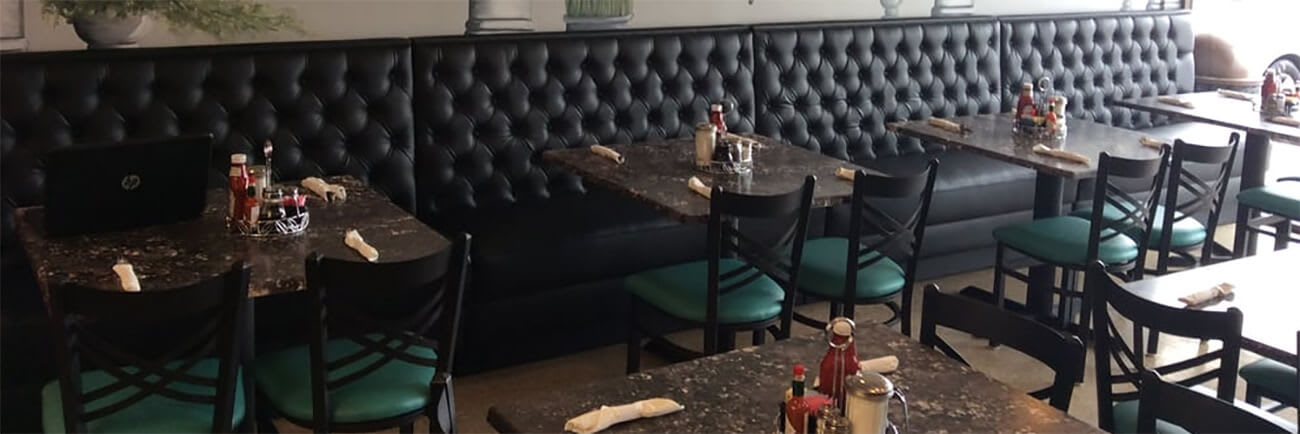
What is a Booth Table?
Before you add restaurant booths and booth tables, you need to measure your space as well as the
types and sizes of various dining booths available. With
booth sizing, you’ll notice terms like:
- Single: offer seating on one side and a flat back on the other.
- Double: booths in between tables with two backs and two seats.
- Split: booth seating on one side of the table and chairs on the other.
- Deuce: smallest booths that offer seating for just two people across the table from one another.
Having the precise restaurant booth design can be a big factor in providing comfortable seating and allowing wait staff to serve guests. It is therefore crucial for restaurant owners to have the correct booth specifications, accurate measurements and the right style of booth table to ensure table turnover and efficient seating.
The basic definition of a booth table is simply a restaurant table that is used in conjunction with a restaurant booth. Often it refers to rectangular table tops that fit well with single and double booths, both regular and deuce size.
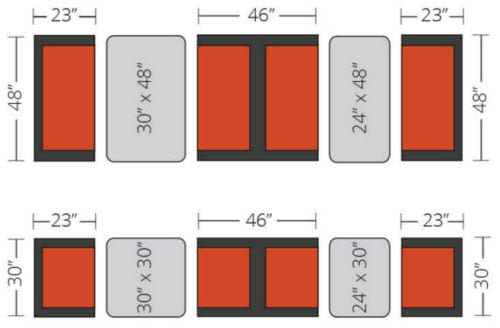
However, with ½ circle and ¾ circle booths the booth table tops usually come with one corner cut off at a 40 degrees angle to ease access to the seats and allow for a more comfortable service.
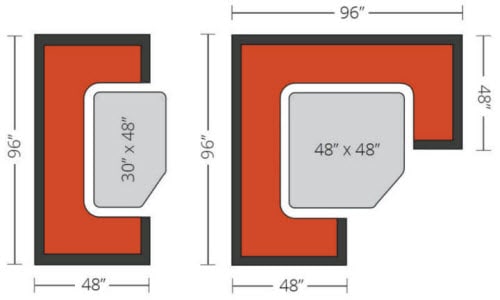
Regardless of the booths used, the most popular booth table tops are either laminated or solid wood.
Booth and Table Sizes
The table below sums up the above diagrams:
| Booth Type | Table Top size | Recommended Table Base |
| Standard Booths – 48” Long | 30” x 48” or 24” x 48” | 22" x 30" X Prong -OR- 22" Round |
| Deuce Booths – 24” Long | 30” x 30” or 24” x 30” | 22" x 22" X Prong -OR- 17" Round |
| ½ Circle Booth – Length: 48” x 96” x 48” | 30” x 48” with Corner Cut | 22" x 30" X Prong -OR- 22" Round |
| ¾ circle booth – Length: 48” x 96” x 96” x 48” | 48” x 48” with Corner Cut | 30" Round |
Booth Tables Types and Differences
Strong laminate materials are used for booth tables as they are resistant to heavy use and easily cleaned. They are also cheaper than solid wood tops and are more suited to the environment they will be used in. The cut corner is added to maximize usage and comfort and to enhance the décor.
Laminate tables normally differ by the laminate and edge types. There are thousands of laminate options available by Wilson Art and Formica. The laminate color and design would usually be selected based on the dining type and venue decor. On the other hand, the edge type is what usually confuses most buyers. Laminate tables are available in 5 edge types.
| Image | Name | Edge Description |
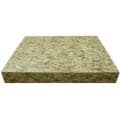 |
Self Edge | The edge would match the laminate on the surface of the table |
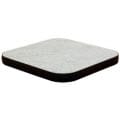 |
T Mold | Rubber edging, usually in black |
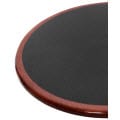 |
Inlay | 1 1/2" nominal wood edge. The wood edge can be stained in various finishes |
 |
Overlay | 3/8" nominal wood edge. Can be stained in various finishes |
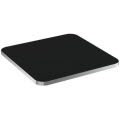 |
Aluminum | Aluminium edge, shiny, mostly used with diner booths to achieve a retro look |
Solid wood is comparatively more expensive than laminate but adds warmth and gives your restaurant a more upscale look. You can find butcher block and plank among our collection of solid wood table tops.
| Image | Name | Table Top Description |
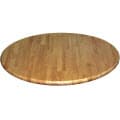 |
Butcher Block | Constructed of 1 1/2" thick solid wood where the wood is also face glued. The wood board width ranges between 1/2" to 2" while the length varies |
 |
Plank | Constructed of 1 1/2" thick solid wood where the wood board width usually varies between 3" and 6", glued side to side |
Booth Tables and Bases
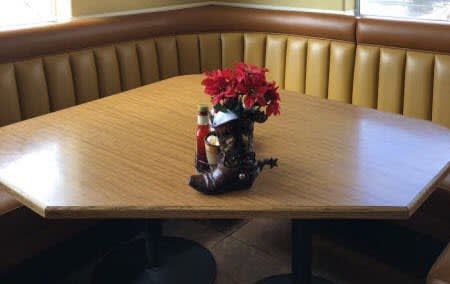
Matching the right table base with your booth table is also an important decision. For single and double booths one option is connecting your table to a wall using a cantilever base which allows for more leg room and requires less cleaning and maintenance.
This type of base however needs to be properly installed and checked upon periodically to ensure the table is still holding on well and can sustain both the weight of the food and people leaning on it.
On the other hand, a cantilever base can't be used with ½ and ¾ circle booths, in which case sturdy single column X-prong or disc bases are recommended and depending on your decor you can choose between more expensive but visually attractive aluminum or chrome bases and less conspicuous cast iron ones.
The right booth table top assembled with the right base can make a big difference not only in your décor but also effect your customers's dining experience. The more ejoyable their dining experience is, the more likely they are to return and spread the good word about your restaurant to draw more customers.
